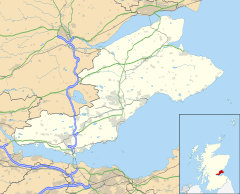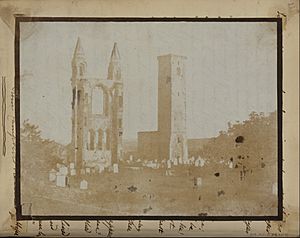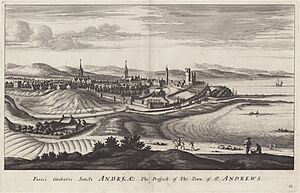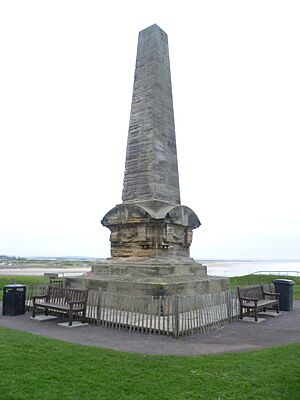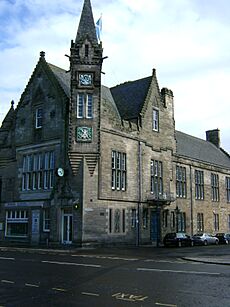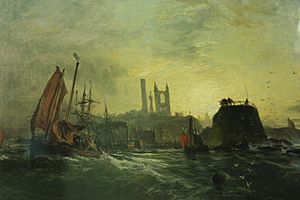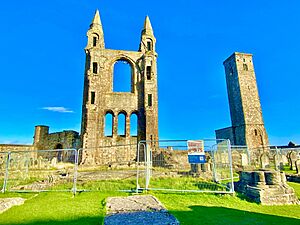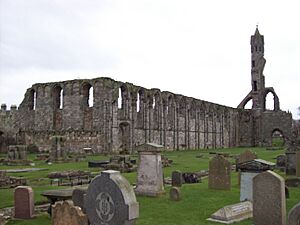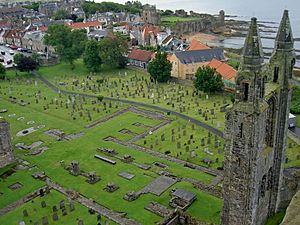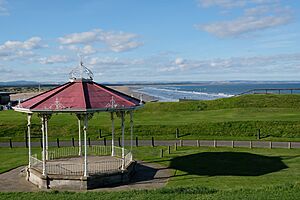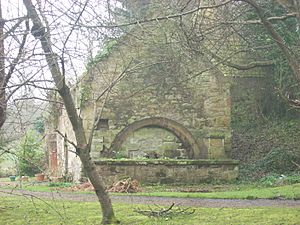St Andrews facts for kids
Quick facts for kids St Andrews
|
|
|---|---|
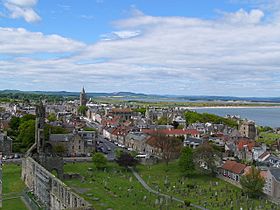 St Andrews, seen from the top of St Rule's Tower |
|
| Population | 18,410 (2020) |
| OS grid reference | NO507168 |
| • Edinburgh | 30 mi (48 km) |
| • London | 351 mi (565 km) |
| Council area | |
| Lieutenancy area | |
| Country | Scotland |
| Sovereign state | United Kingdom |
| Post town | ST. ANDREWS |
| Postcode district | KY16 |
| Dialling code | 01334 |
| Police | Fife |
| Fire | Fife |
| Ambulance | Scottish |
| EU Parliament | Scotland |
| UK Parliament |
|
| Scottish Parliament | |
St Andrews is a famous town on the east coast of Fife in Scotland. It is about 10 miles (16 km) southeast of Dundee and 30 miles (48 km) northeast of Edinburgh. In 2011, about 16,800 people lived here. This makes it the fourth-largest town in Fife.
The town is home to the University of St Andrews. This is the third oldest university in the English-speaking world. It is also the oldest university in Scotland. It has been ranked as one of the best universities in the United Kingdom.
St Andrews is named after Saint Andrew, one of Jesus's apostles. The town grew around the St Andrews Cathedral. This cathedral was once the biggest church in Scotland. Today, it is mostly in ruins.
Many people know St Andrews as the "home of golf". This is because of The Royal and Ancient Golf Club of St Andrews. This club helped set the rules for golf worldwide for many years. The famous Old Course is also here. It is one of the most important golf courses in the world. It often hosts The Open Championship, which is golf's oldest major tournament. People visit St Andrews to play golf and enjoy its sandy beaches.
You can also find the Martyrs Memorial here. It honors people like Patrick Hamilton who died for their beliefs during the Reformation. The town also has museums, a botanic garden, and an aquarium.
Contents
- What's in a Name?
- A Look Back in Time
- How the Town is Run
- Who Lives in St Andrews?
- What Makes the Economy Go?
- Weather in St Andrews
- Getting Around St Andrews
- Local News and Entertainment
- Famous Places to See
- Learning in St Andrews
- Sports and Fun
- More Places to Explore
- St Andrews Around the World
- Special Honors
- See also
What's in a Name?
The very first name for this area was Cennrígmonaid. This is an old Gaelic word. It means "head" or "peninsula of the king's moor." Later, it became Cell Rígmonaid, meaning "church of the king's moor." The modern Gaelic name is Cill Rìmhinn.
The name St Andrews comes from a legend. People believed that the bones of Saint Andrew were brought here. A saint named St Regulus (or Rule) supposedly brought these important relics. A shrine was built to keep them safe. Then, the town was renamed to honor Saint Andrew.
You might notice that the name "St Andrews" does not have an apostrophe. This is because the town was named before apostrophes were commonly used in the English language.
A Look Back in Time
Early Settlers
The first people lived near the rivers Tay and Eden. This was during the Middle Stone Age, between 10,000 and 5,000 BCE. Later, around 4,500 BCE, nomadic people settled here. They cleared forests and built monuments.
During the Iron Age, a strong fort was built on East Balrymonth hill. This is about a mile south of the town. You can still see its outline from above today. It is the oldest structure still existing in St Andrews.
The Rise of the Monastery
Around the mid-700s, a monastery was built by the Pictish king Oengus I. This monastery was linked to the relics of Saint Andrew. Legend says that Saint Regulus brought some of Saint Andrew's bones here.
In 877 AD, King Causantín mac Cináeda (Constantine I) built a new church for the Culdees in St Andrews. In 906 AD, the town became the main church center for Alba (an old name for Scotland).
Building the Town
The town we see today started around 1140. Bishop Robert began building it on an L-shaped hill. The new town was built west of the Cathedral. This led to the creation of streets like North Street and South Street.
St Andrews became very important in medieval Scotland. It was a major place for pilgrimage. People came from all over hoping to be blessed or cured at Saint Andrew's shrine. This brought more trade and helped the town grow. St Andrews became the church capital of Scotland. It had a lot of power and influence in Europe.
Changes and Growth
In 1559, the town faced hard times after the Scottish Reformation. It lost its status as the church capital. Even the University of St Andrews thought about moving away in the late 1600s.
But by the 18th century, St Andrews became known for its golf courses. In the 19th century, the town started to grow again. New houses and villas were built outside the old medieval walls. Today, St Andrews is known for its education, golf, and tourism.
How the Town is Run
St Andrews is part of the North East Fife area. This area elects one MP to the UK Parliament. The current MP is Wendy Chamberlain.
For the Scottish Parliament, St Andrews is also part of the North East Fife area. This area elects one Member of the Scottish Parliament (MSP). The current MSP is Willie Rennie. These people represent the town and its people in government.
Who Lives in St Andrews?
In 2001, St Andrews had a population of 14,209 people. By 2012, this number grew to about 16,800. A large part of the population (37%) is made up of young people aged 16 to 29.
Most people living in St Andrews (87.78%) were born in the United Kingdom. About 61.80% were from Scotland. Many people in St Andrews are students. This is because of the university.
What Makes the Economy Go?
St Andrews' economy is worth about £660 million. It mostly depends on two things: tourism and education. In 2016, one out of every five jobs in St Andrews was linked to tourism.
St Andrews is sometimes seen as an expensive place to live or visit. For example, in 2016, The Scores street was reported to have the most expensive houses in Scotland.
Weather in St Andrews
St Andrews has a mild temperate maritime climate. This means it's not too hot or too cold, even though it's quite far north. Winters are usually mild, with average temperatures around 4°C (39°F). It can get windy, and frosts are common at night. Snowfall is not very frequent.
The warmest temperature ever recorded was 31.3°C (88.3°F) in July 2022. The coldest was -14.5°C (5.9°F) in February 1972. St Andrews is one of the driest parts of Scotland, getting about 650 mm (25 inches) of rain each year. It also gets a good amount of sunshine, over 1,500 hours a year.
Getting Around St Andrews
Buses and Trains
St Andrews used to have a train station, but it closed in 1969. Now, to catch a train, you go to Leuchars railway station. Buses are the main way to get around. The Stagecoach bus station is near the town center.
Route 99 buses connect St Andrews to Dundee via Leuchars. They run very often. Other bus services link the town to places in Fife and even further away, like Edinburgh.
Airports and Roads
Dundee Airport is about 15 miles (24 km) north of St Andrews. It has flights to London and Belfast. If you're driving, several main roads like the A91 and A915 lead into the town.
Local News and Entertainment
You can get local news and TV from BBC Scotland and STV North. For radio, there's BBC Radio Scotland and local stations like Kingdom FM. There's even a community radio station called St Andrews Radio, run by the University of St Andrews.
The local newspaper is The St Andrews Citizen. The university also has its own student newspapers, The Saint and The Stand.
Famous Places to See
St Andrews once had several town gates, called "ports." Two of them are still standing. The West Port is one of the few old town gates left in Scotland. It has tall towers and a central archway. It was rebuilt between 1843 and 1845.
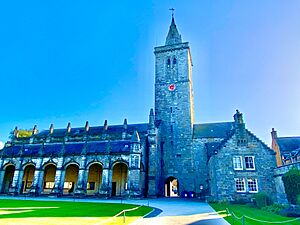
Holy Trinity Church
The Holy Trinity Church is the oldest church in St Andrews. It was first built around 1144. It was moved and rebuilt between 1410 and 1412. The church was restored in the early 1900s to look more like its medieval self.
St Andrews Cathedral
East of the town center are the ruins of St Andrews Cathedral. This was once the largest building in Scotland. It was started in 1160 and finished in 1318. Robert the Bruce, a famous Scottish king, was there for its opening. Next to it is St Rule's Church, which is even older, from around 1120. Its tall tower was built to hold the relics of St Andrew.
St Andrews Castle

The ruins of St Andrews Castle sit on a cliff overlooking the sea. It was built around 1200 as a home, prison, and fortress for the bishops. It was rebuilt many times after being damaged in wars.
Most of the castle you see today was built between 1549 and 1571. It was designed to be a comfortable palace but still strong for defense. After the Reformation, the castle fell into ruin. Today, Historic Environment Scotland looks after it.
You can also see parts of the old Dominican friary, Blackfriars, on South Street.
Learning in St Andrews
St Andrews has one secondary school, one private school, and three primary schools.
Primary Schools
- Canongate Primary School opened in 1972.
- Lawhead Primary School opened in 1974.
- Greyfriars Primary School is a Roman Catholic school.
Madras College
Madras College is the main secondary school. It opened in 1833. It was founded by Andrew Bell, who wanted to teach both poor and rich children together. The school used to be on two campuses. A new building for the school was finished in 2021.
St Leonards School
St Leonards School is a private school. It started as a girls' school in 1877. It is now spread across thirty acres. A boys' private school, New Park, joined with St Leonards in 2005.
University of St Andrews
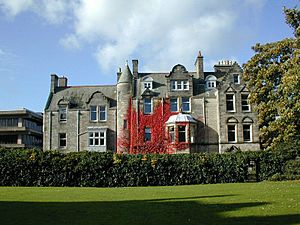
The University of St Andrews is the third oldest English-speaking university. It is also the oldest university in Scotland. It was founded between 1410 and 1413. It started as a group for learned men studying law, arts, and religion. The university has several old colleges, like St Salvator and St Leonard.
Sports and Fun
Golf: The Home of Golf

St Andrews is famous worldwide as the "home of golf." Golf has been played here since at least 1552. The most famous course is the Old Course. It is very old, dating back to medieval times. It often hosts The Open Championship. Famous golfers like Jack Nicklaus and Tiger Woods have won here. Nicklaus once said, "if a golfer is going to be remembered, he must win at St Andrews."
There are seven golf courses in St Andrews: Old, New, Jubilee, Eden, Strathtyrum, Balgove, and the Castle. The Castle course was added in 2007.
Other Sports
St Andrews also has a canoe club, a football club (St Andrews United), a rugby club (Madras Rugby Club), and a tennis club. The East Sands Leisure Centre has a swimming pool and gym.
West Sands Beach
West Sands Beach is 2 miles (3 km) long. It is next to the famous St Andrews Links golf course. This beach was used for the opening scene of the movie Chariots of Fire. This scene was even re-enacted during the 2012 Olympics torch relay. The sand dunes on the beach help protect the golf course.
More Places to Explore
Byre Theatre
The Byre Theatre was started in 1933 by Charles Marford and Alexander B. Paterson. The current building opened in 2001. It has a main stage and a smaller performance space. Some people say the theater is haunted by the friendly ghost of Charles Marford!
Lade Braes Walk
The Lade Braes Walk is a beautiful public path. It is about 1.5 miles (2.4 km) long. It follows the route of an old medieval mill lade. A lade is a channel that carries water. This lade brought water from the Kinness Burn to a water mill near the Cathedral. The walk goes through Cockshaugh Park to Law Mill. The remains of Law Mill and its water wheel are still there.
St Andrews Museum
The St Andrews Museum is a local museum. It focuses on the history of St Andrews. It opened in 1991 and is in Kinburn Park. It has many historical items from the town, from ancient times to the 20th century.
University Museum
The Museum of the University of St Andrews tells the story of the university. It's free to enter. You can learn about how the university started, student life, and important inventions. Highlights include medieval maces (ceremonial staffs) and an old astrolabe from 1575.
Botanic Garden
The St Andrews Botanic Garden is a large garden with 18 acres. It has over 8,000 different kinds of plants from all over the world. You can see woodlands, meadows, and even a butterfly house in one of the greenhouses. There is usually a small fee to enter.
Aquarium
The St Andrews Aquarium is located on the cliffs overlooking West Sands. It's a family-owned place. You can see many types of fish, penguins, marmosets, meerkats, and seals. They have daily feeding shows for the animals.
St Andrews Around the World
Since 2015, St Andrews has been officially twinned with the French town of Loches. This means they have a special friendship and share cultural exchanges.
Special Honors
Some people and military groups have been given the "Freedom of the City and Royal Burgh" of St Andrews. This is a special honor.
Individuals Honored
- Benjamin Franklin: 1759.
- Victor Bruce, 9th Earl of Elgin: 1902.
- Edward, Prince of Wales (who later became King Edward VIII).
- Robert Tyre Jones Jr.: 1958.
- Jack Nicklaus: 2022.
Military Units Honored
- Army Leuchars: 2015
See also
 In Spanish: Saint Andrews para niños
In Spanish: Saint Andrews para niños


